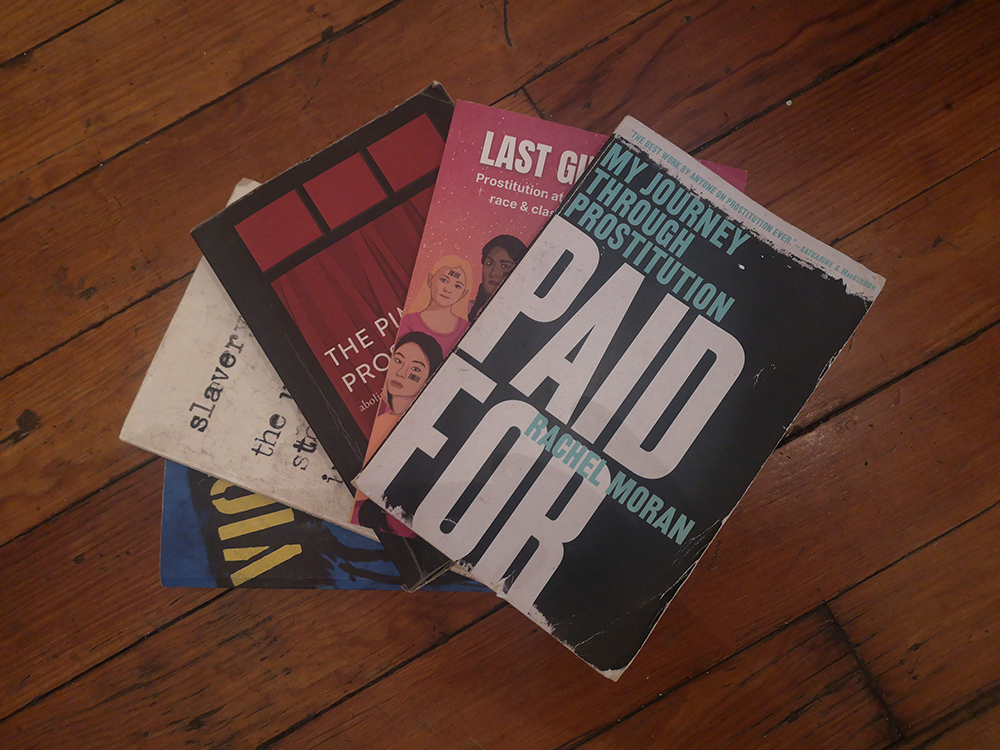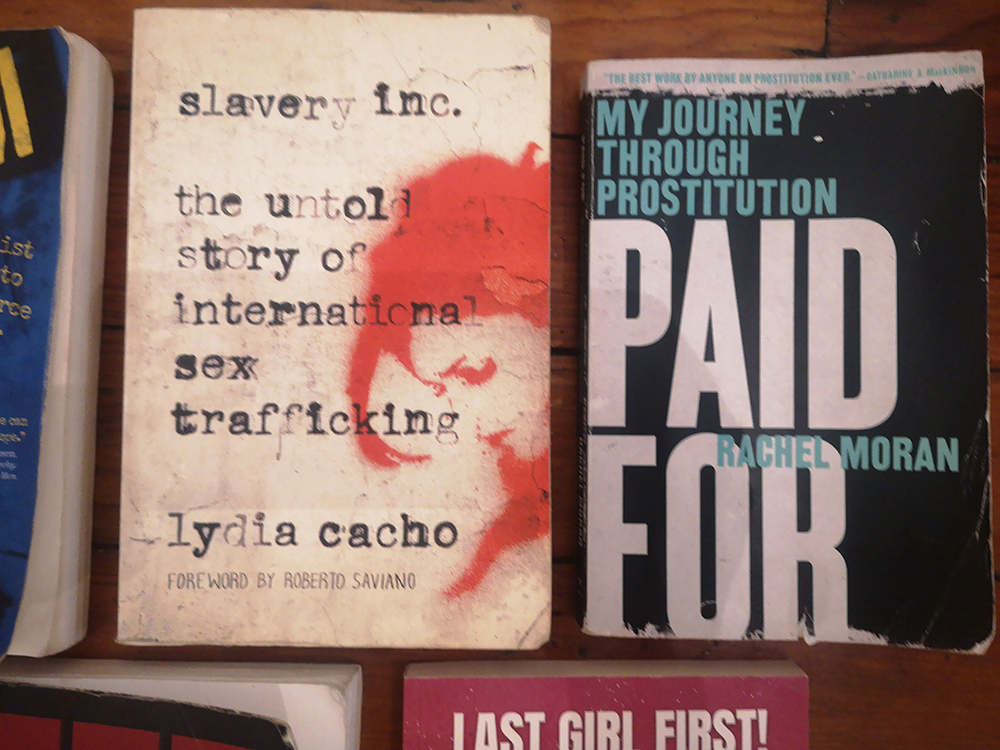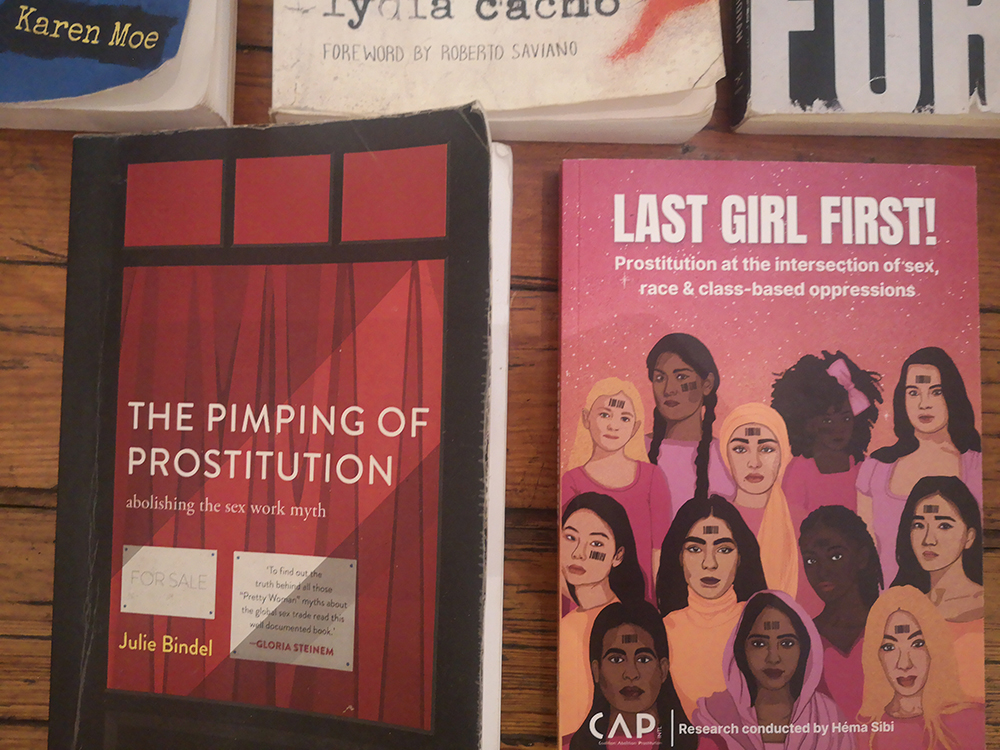What fresh hell is this?
Or, you’ve got to be kidding. But this fresh hell is far from it as in something shiny and new, not to mention ground-breaking as it is represented as being. And, always unfortunately when maintaining a culture of exploitation, there’s no you’ve got to be kidding me. There it was. On the shelf in the Memoir and Culture section in the privileged book-store position of cover-facing-forward, a glossy hard cover printed in a custom (read expensive) format: Modern Whore. The thing is: there’s nothing ‘modern’ about it. Disguised in the latest lingerie, this horrifying reality is another case of same-old-same-old.
Again, unfortunately, it’s impossible to miss the come-hither cover. Innocent barrettes that decorate a demure side-part hearkening back to the innocence of 1950s bobby-socks are meticulously combined with huge hoop earrings that have been worn by African American and LatinX women as symbols of strength and resistance for decades. However, in a white-supremacist patriarchy where women and girls of colour are oppressed by the stereotype of hyper-sexualization and the reality of their over-representation in prostitution,[1] this combination of the submissive goody-two-shoes (read: white) and appropriation of women of colour don’t-mess-with-me resistance fulfills the patriarchal ridiculousness of the virgin/whore dichotomy and, to male fantasy and delight, in one female body. Internalized sexism is also present as contemporary young womanhood aspires towards female empowerment through only their sexuality; there is no revolution here as said liberation is motivated by the continued prioritization of the male gaze and maintaining his dominance in the capitalist free (for them) market of men buying women’s bodies.

In her opening sentence, the Modern Whore announces triumphantly that she worked as a sex worker for five years. And, yes, naturally, as a representative of this new generation of ‘happy hooker,’ she worked as an agency escort. What does that mean exactly? It means that she never has been on the street barely surviving—or leaves out this part for the sake of marketing the delusional, albeit profitable, glamor of selling one’s body (predominantly women and girls) to be used by another (the extreme majority men).[2]
She leaves out or is blissfully unaware
of the coerced ‘choice’ of being a prostituted person because of economic, race, gender, mental illness, and drug addiction. All of these factors connect to poverty and, as is logically reported in Last Girl First, “[s]ex buyers would not have access to women’s bodies in the first place if the women were not in situations of immense financial insecurity and fighting for survival.”[3] As one of many irrefutable statistics in CAP International’s 2022 publication Last Girl First!: Prostitution at the intersection of sex, race, & class-based oppression, when interviewing two hundred prostituted people on the streets in San Francisco, 88% of respondents and 92% of the minors considered themselves ‘very poor’ or ‘barely surviving [and] when asked why they ‘entered’ prostitution, 89% said ‘needed money’ and ‘hungry.’”[4] Prostitution survivor Rachel Moran sums it up: “The only thing that prostitution ever liberated me from was homelessness.”[5]
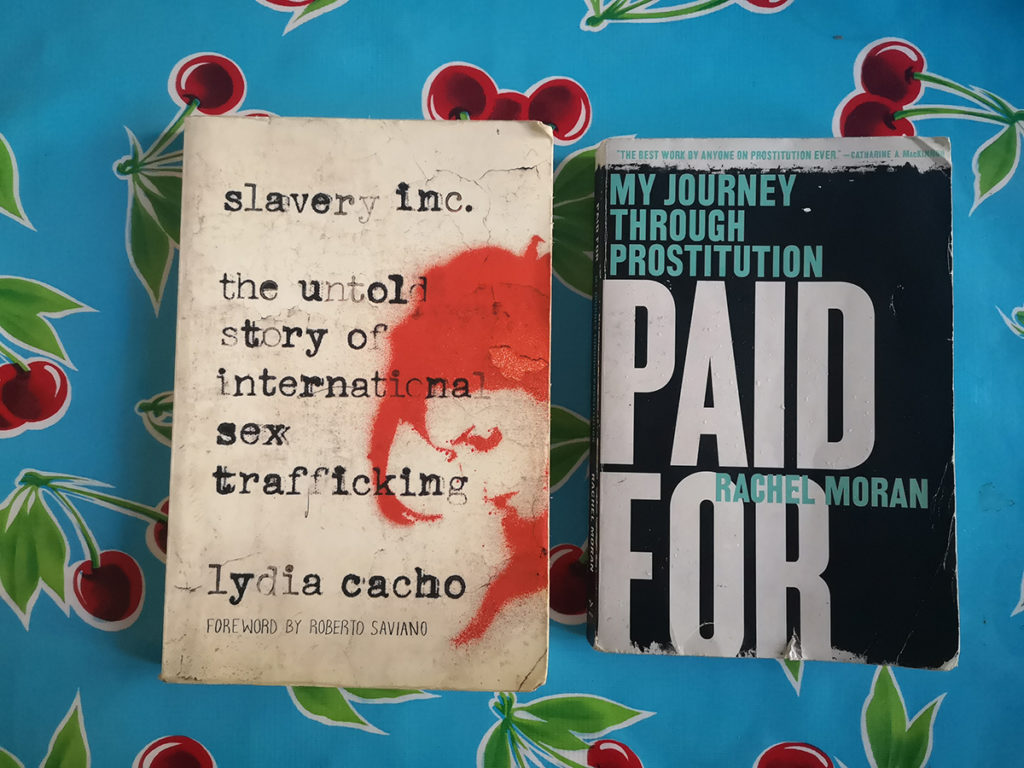
These books tell the truth.
However, as Moran testifies in her memoir Paid For: My Journey Through Prostitution when she was prostituted both on the street and as an escort “no area has a monopoly on degradation … [and] it is just as customary to be humiliated in a five-star hotel.”[6] Last Girl First reports: “incorporating the classification of ‘high-end’ and ‘low-end’ prostitution poses a real societal danger. The myth of glamourous prostitution makes the reality of prostitution invisible whether it is on the street or indoor, it is based on commodification, objectification of women, exploitation of vulnerabilities and male violence.”[7]
Not only has it been framed that this self-proclaimed Modern Whore seems to have missed all of this reality and, like her foremother happy hookers like Annie Sprinkle and Scarlot the Harlot who entered prostitution out of curiosity, intrigue and fascination,[8] the Modern Whore simply retired from escorting. No struggle. No stress. As Annie Sprinkle says while candy-coating the exploitation of the majority of prostituted women and children in her bizarre “13 Tips to Cure Sex Worker’s Burn Out Syndrome”: if you are working as a so-called sex worker and start to feel ‘burned out’ (read: in prostitution survivor and activist Brenda Myers-Powell’s words, after “having your body used like a toilet by at least five men a day”)[9] “[s]pend time alone, get in touch with your feelings, be aware of what colours you wear and, if the Sex Worker’s Burn Out Syndrome is chronic, get the hell out of the business.”[10] The Modern Whore doesn’t say why she ‘retired.’ Apparently, she just up and left with no pimps or sex traffickers after her as is so common that there are thousands of safe houses for women in North America not only providing shelter for battered women, but also for prostituted women trying to escape violent pimps.[11]
To make things even more wholesome
for the chipper Modern Whore, when she retired, she went to work on an organic farm. Okay, I’m sorry, this is too perfect! Such a politically correct choice of a retirement occupation definitely adds to the marketability of the book and the sanitisation of the sex trade! I’m not denying that any of this isn’t true. I have no idea. And it doesn’t matter if it’s true or not as books have the power to contribute to what we think and the subsequent creation of reality. As Donna J. Haraway enlightens: “[i]t matters what thoughts think thoughts.”[12] In capitalist consumer culture, popular culture is the source of what can be referred to as the ‘master’ thoughts that generate, yes sorry free-will folk, what we think. And sells out books.
Regardless, lucky her. But how does this invisibilization of power abuse that drives the sex industry affect not only all women (prostituted or not),[13] but the world as a whole in terms of maintaining a system of exploitation? But here she is, celebrating that which devastates and destroys, effortlessly exiting prostitution with the privilege of joining a golf club upon retirement; off she goes to work on an organic farm where she can take off her appropriated hoop earrings and embrace the purity of her barrettes.
But wait:
I thought that the dominating doctrine of political correctness threatens to cancel us if we don’t only use the term ‘sex worker’ to refer to the majority of people who have been coerced in a variety of ways to have their bodies sold for sex or risk being SWERFED[14]. The Modern Whore and her sensationalization of the term in her title and Sprinkle with her extensive list “Why Whores are my Heroes” celebrate the signifier ‘whore,’ a term that hearkens back to the male sex buyer stereo type “The good whore with the golden heart.”[15] Cosi Fabian, another 90s pro-sex work trail blazer with her mantra of The Holy Whore: A Woman’s Gateway to Power, describes prostitution as the ultimate form of female empowerment. Unbelievably, Sprinkle actually goes so far as to proclaim prostitution a ‘public service.’ Thankfully, Moran brings us back to the reality of the sex trade for the majority: “[w]omen who contend they enjoyed prostitution simultaneously do not present the experience as it is really lived. It is therefore not prostitution they are defending; it is an incomplete version of it.”[16]

In the beginning of the book, the Modern Whore relates how she met her photographer: “I regaled her with stories from my escorting years and posed for pictures in tractors and hay bales. We knew we had to make art together.” Okay, art, that has the right to call itself so, has nothing to do with repetition. Art is about innovation. Art is about offering spaces—be they through poetry, literature, visual art, performance, music—where we can immerse ourselves in something new, a reality that has been here all along and requires the artist to show it to us. Art is about transformation. Art is about creating alternative thoughts to think with. Again, as another layer of clichéd sexism that the Modern Whore presents as something she has thought up herself, if one Googles “sexy woman hay photos,” like the centuries of female oppression in patriarchy, the instances are endless. The only thing different (sort of as it’s been going on since the turn of the twenty-first century) is that the young woman is objectifying herself.
Okay, seeing as art has come up, let’s analyse the photographs as if they actually are.
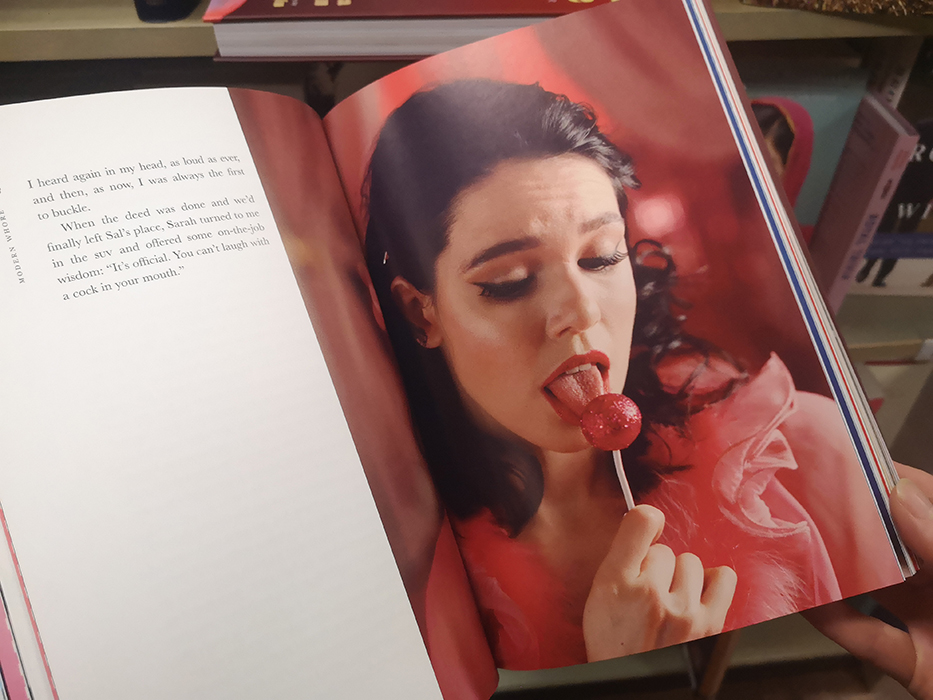
There she is: eyes downcast with that titillating blend of innocence and naughtiness, brow slightly furrowed in a state of faux worrying or a girly-girl pout that narrates the age-old male fantasy of victimization and the oh-so-violatable female vulnerability. There she is: demurely licking a lollipop, 3 mouth soft and ready to replace the lollipop with a cock. Who comes immediately to mind? Nabokov’s Lolita, of course. And, in terms of non-art as repetition, surprise: minus Lolita’s sunglasses, the modern whore’s cover is an absolute copy-cat for one of the promotional photos for Stanley Kubrick’s 1962 film of Vladimir Nabokov’s controversial and ground-breaking work of literature. However, unlike Nabokov who problematizes the psychology and pathology of a pedophile, this modern-little-girl-whore-come-and-shove-your-cock-in-my-mouth-daddy photo is but a repetition of what men who abuse power want to remain. The Modern Whore is an irresponsible hyperbole and a reductionist Lolita, a character who is meant to complexify pedophilia, not sensationalize it.

During her international investigation of the sex trade, journalist Lydia Cacho reports how sex tourists in Cambodia will pay $300 US to rape a child/virgin.[17] Because there is so much more money to be made exploiting children is why traffickers look for younger and younger girls. Last Girl First explains: “The demand of sex buyers for ‘virgin’ girls illustrates the relationships of control and domination at work in the prostitution system. The criterion of virginity is a real ‘selling point,’ with sex buyers seeking ‘purity,’ submission and docility. In Mexico, for example, so-called ‘virgin’ girls are specifically trafficked to gangs and armed groups who seek to ‘offer’ them to buyers willing to pay a high price.”[18] This is an ideology of misogyny and power abuse and anything, even a shiny coffee table book that proclaims sex-work can provide easy money, freedom, joy and a lot of [sex-positive feminist] d—k, serves the impunity of male violence.
But what’s the harm in a little fun?
Oh, Logical Feminist, you take everything too seriously. You’re such a downer! Look: she’s just playing with bananas. And guess who also eats a lot of bananas! Surprise! Lolita! However, where there is pathos to Lolita’s banana eating, the Modern Whore’s fetishization of banana/cocks is a superficial rendering of a work of art that opens us to sensations and questions previously unthought.
And, yes, sigh, yawn, there she is, shot from above as the photographic angle of domination, surrounded by a circle of jerks (don’t excuse the pun). Once again, with brow furrowed as a little girl not-quite-sure-what’s-going-on-but-doing-it-anyway expression,[19] kneels the modern whore. The lollipop hasn’t been replaced by a literal cock quite yet; however, the four circle jerks are holding their personal banana/cocks as some sort of benevolent offering—three of them with hairy distended bellies who would never be able to have sex with a beautiful young woman unless they paid her (which is of course what is being represented). As in all pornography that features an exploited woman, the abusers are not fully in the shot as their impunity is literally a part of the composition. However, they are all holding their bananas at crotch cock hard-on level as the Modern Whore takes turns getting off the all-in-good-fun pieces of fruit.
The punctum of the shot, though, the key to the reality of the photograph, the detail that could easily go unnoticed if one is flipping through the book either aspiring to be like her or straight up jerking off to her is the male hand on her head, poised to push her face cock-ward. This is the truth of the image: the fact that, even though she acts as though she’s into it, structurally speaking, this circle jerk play pen represents force, be it ideological or literal or both—and women having their heads shoved down against their will to suck off a man is the opposite of novel.
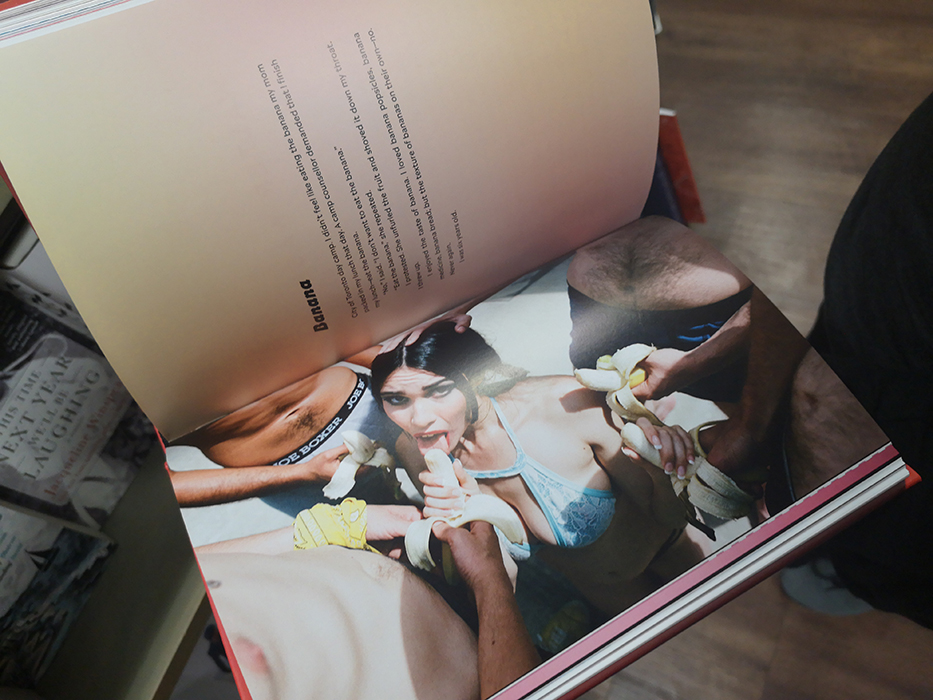
Here is what the Modern Whore’s banana photograph really means. Researched by Robert Jensen for his article “Blow Bangs and Cluster Bombs: The Cruelty of Men and Americans”: “ Blow Bang #4 is a video tape made and sold in America. It is a videotape that American men watch and masturbate to. It consists of eight different scenes in which a woman kneels in the middle of a group of three to eight men and performs oral sex on them. At the end of each scene, each of the men ejaculates onto the woman’s face or into her mouth. The copy on the video box describes it this way: ‘Dirty bitches surrounded by hard throbbing cocks—and they like it.”[20]
“It’s official. You can laugh with a cock in your mouth,” says the Modern Whore’s photographer after the banana/cock shoot. I guess you can if you don’t care about anyone except yourself.
I know, I know,
the happy hookers and modern whores are so much more fun! Only thinking about yourself is so much easier and, therefore, more fun. Not thinking at all is more fun! Trying to change the way things we have been trained to think have always been this way is so hard! But who is all of this indolent fun for, anyway? There is no fun being had by the women and children who often have to service more than ten men per day and need to disassociate in order to, as I say in Victim, “paradoxically keep it together.”[21] Rachel Moran certainly wasn’t having any fun when she was living how: “[i]t is difficult to describe how hollow a woman feels after she has been used sexually by ten different men.”[22] Maybe the modern whore is one of the estimated 1% who actually may have exercised some level of ‘free will,’ or maybe she isn’t telling us everything as a fool-proof marketing scheme in a male supremacist market. However, as Meghan Murphy wrote during her years extensively researching the hypocrisies and harms of so called sex-work as regular work like all others, the modern whore’s sensationalization of her personal fun servicing male domination serves to “drag everyone else under the bus.”[23]
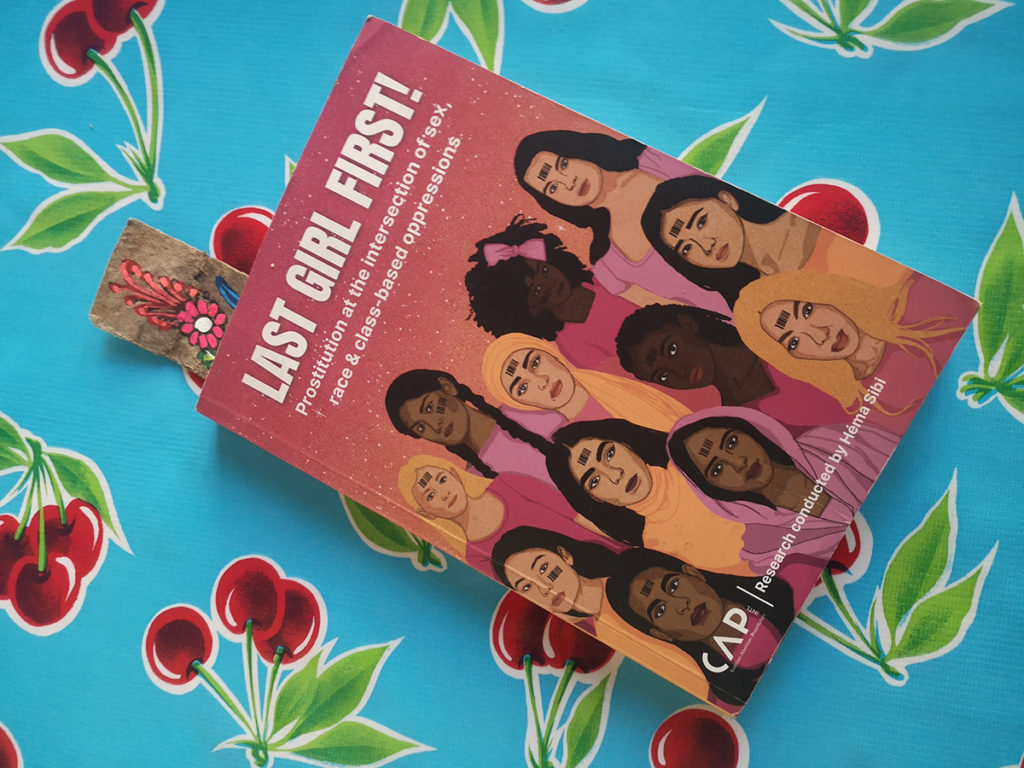
Read this book.
As is sagely stated in Last Girl First, the myth of the glamourous sex-worker “fails to analyse the prostitution system in a structural way but rather derives from an individualistic, capitalistic and ultra-liberal vision.”[24] The lethal and profitable combination of individualism and capitalism have resulted in a global, patriarchal, free market culture where everything, especially the bodies of women and girls, has a price. “The core of prostitution’s true nature … [is] the commercialisation of sexual abuse,”[25] proclaims Rachel Moran. It’s no wonder that the Modern Whore is, as described in its Amazon synopsis, an “engorged edition of the sold-out memoir-cum-art book,” as it plays into the system that sells it. “It’s Playboy if the Playmates were in charge,” is the Modern Whore’s elevator pitch as revolutionary fraud because, beneath all of this thoughtless fun, this has nothing to do with play. The playmates are the partners of what Sayak Valencia calls “the most ferocious type of neoliberalism”[26] where personal liberation is actually so many other people’s prisons and, maybe when one lets go of their cock and thinks, hers too.
#iloveendnotes
[1] Last Girl First: Prostitution at the intersection of sex, race & class-based oppressions put out by CAP International (Coalition Abolition Prostitution) with the research (and I mean RESEARCH by Héma Sibi) in March 2022. 18. I believe, and will be reviewing the book in the Logical Feminist shortly, that if you read this book, there is no way you could continue to support and apologize for the sex industry—and, if you still can, you haven’t really read it (or felt it).
[2] First World women go to such locales as the Dominican Republic and Jamaica with the intentions of having sex with young, exoticized, locals men; however, the percentage is very small in comparison to the millions of men who travel abroad for sex with young women and girls and any abuse involved— like between the women (or girls) and the men— is non-existent. The title of Tanika Gupta’s 2006 play ‘Sugar Mummies’ is telling in that the women have taken on the behaviour of ‘sugar daddies,’ not rapists; nevertheless, using one’s economic privilege to access another human’s body upholds a culture of domination and violence that is inherent to masculine supremacy.
Journalist and author Julie Bindel points out in her 2013 article, the women who travel south “are looking for attention and excitement but end up, often without realising it, being one half of a prostitution deal.” Of course, as with the male sex tourist trade, poverty is the key component due to the economic disparity between the First and Third Worlds and the young men would most likely not have sex with the middle-aged women from the north if they did not have, and give them, money. The trend of women buying sex in tourist destinations like Jamaica can also be connected to female ‘raunch culture’ where fun feminists of the US, Canada and Northern Europe are all about sexual prowess and have, out of proclamations of sexual liberation, adapted patriarchal behavior. See Julie Bindel: https://www.dailymail.co.uk/femail/article-2401788/Sex-tourism-Meetmiddle-aged-middle-class-women-Britains-female-sex-tourists.html https://www.theguardian.com/commentisfree/2006/aug/09/comment. gender
[3] Last Girl First: 60
[4] Ibid.
[5] Moran: 152.
[6] Ibid: 90.
[7] Last Girl First: 158-159.
[8] Carol Leigh aka Scarlot the Harlot coined the term sex-work. She writes in her article, “Inventing Sex Work”: “I had fantasies of being a prostitute, but had never considered actually doing it …. At least I could try it … just try it …. From the very first day I was fascinated …. I was excited and intrigued to be in this environment, working with women from all over the world who were surprisingly strong and smart” Whores and Other Feminists, 227.
[9] As reported by prostitution survivor and co-founder of the Dreamcatcher Foundation Brenda Myer-Powell in Last Girl First: 159.
[10] Annie Sprinkle “13 Tips to Cure Sex Worker’s Burn Out Syndrome” in Whores and Other Feminists Jill Nagle ed.: 67.
[11] In Canada alone, there were 557 safe houses in 2021/22 that are supported by the Canadian government. This statistic does not include private facilities (or the US).
https://www150.statcan.gc.ca/n1/daily-quotidien/220412/dq220412b-eng.htm
[12] Donna J. Haraway Staying with the Trouble: Making Kin in the Chthulucene. Durham and London: Duke University Press, 2016: 35.
[13] As Moran writes in Paid For: “Some women have no problem with pornography. Well, I do. I know from having been photographed in sexually explicit poses that there is a lot more going on behind these glossy graphic images than most people take the time to consider. It is a demeaning and exploitative business that is hugely damaging to women, both within and without the industry.”: 73.
[14] Sex Worker Exclusionary Radical Feminist. See … for a further discussion of this reductionist term and dismissive labeling.
[15] The source of my commitment to the abolition of the sex trade was when the serial rapist who abducted me in 1994 stated “There’s nothing like a good whore. The good whore with the golden heart.” As I conclude in Victim: A Feminist Manifesto from a Fierce Survivor, after researching and analysing the Pro-Sex Work and Sex Trade Abolitionist controversy, “there is nothing positive about agreeing with a serial rapist.” Victim: 126.
[16] Moran: 159.
[17] Cacho, Lydia. Infamy: How One Woman Brought an International Sex Trafficking Ring to Justice. Ceclia Ross, trans. New York: Soft Skull/Catapult Press, 2016: 78.
[18] Last Girl First: 49.
[19] Sexually abused children do the same thing as they are psychologically devastated by the confusion when they know the abuse feels bad, but they think it is what they have to do for the adult abuser who is usually a male relative and, hence, have feelings of loyalty and love for the one who is hurting them.
[20] Robert Jensen in “Blow Bangs and Cluster Bombs: The Cruelty of Men and Americans” in Not for Sale: Feminists Resisting Prostitution and Pornography: 28.
[21] Karen Moe Victim: A Feminist Manifesto from a Fierce Survivor. Lantzville BC/Mexico City: Vigilance Press, 2022: 254.
[22] Moran: 52.
[23] https://www.feministcurrent.com/2013/08/02/interview-meghanmurphy-on-the-sex-industry-individualism-online-feminism-and-the-third-wave/
[24] Last Girl First: 159.
[25] Moran: 172.
[26] Sayak Valencia. Gore Capitalism. South Pasadena, CA: semiotext(e) intervention series 24, 2018: 265.

